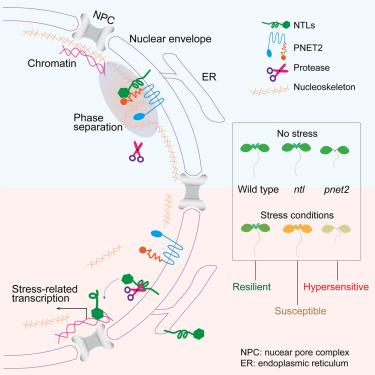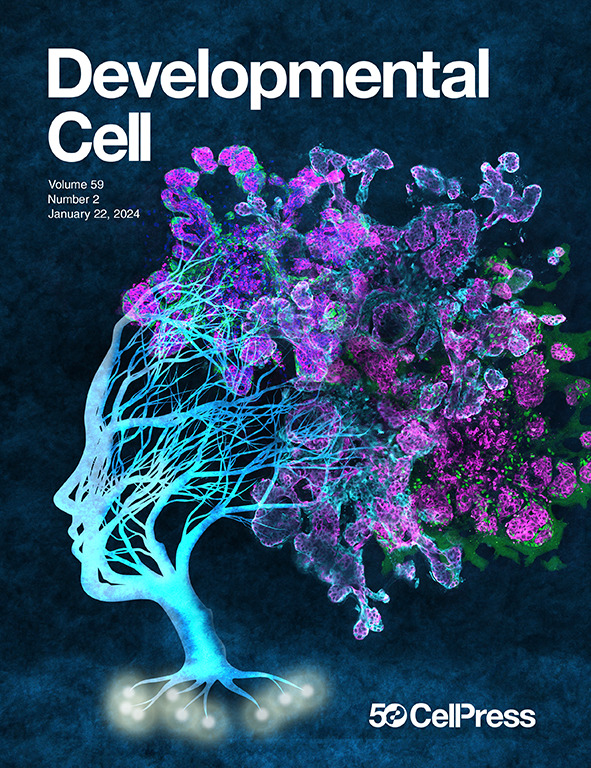Nuclear lamina phase separation orchestrates stress-induced transcriptional responses in plants
IF 8.7
1区 生物学
Q1 CELL BIOLOGY
引用次数: 0
Abstract
The nuclear lamina (NL), a perinuclear protein meshwork formed by nucleoskeleton and inner nuclear membrane (INM) proteins, is crucial for chromatin organization at the nuclear periphery and gene expression regulation in eukaryotic cells. However, NL-dependent transcriptional regulation remains poorly understood in plants due to the absence of most canonical NL proteins found in animals. Here, we report that the plant INM protein PLANT NUCLEAR ENVELOPE TRANSMEMBRANE 2 (PNET2) interacts with membrane-bound NAC (NAM, ATAF1/2, and CUC2) transcription factors, NTLs, via intrinsic disorder regions and promotes liquid-liquid phase separation within the NL. This compartmentalization effectively sequesters NTLs and restricts their transcriptional activity. In the absence of PNET2, NTLs become deregulated, triggering spontaneous and broad-spectrum stress responses. Importantly, we found that stress stimuli, such as heat shock, disrupt PNET2-NTL phase separation, releasing NTLs for target gene binding and transcriptional activation. These findings demonstrate a phase separation-based regulatory mechanism within the NL that controls membrane-bound transcription factor activity in response to environmental cues.

在植物中,核层相分离协调了胁迫诱导的转录反应
核层(NL)是由核骨架蛋白和核膜蛋白(INM)组成的核周蛋白网络,在真核细胞中对核周染色质组织和基因表达调控至关重要。然而,由于缺乏在动物中发现的大多数规范的NL蛋白,植物中依赖NL的转录调控仍然知之甚少。在这里,我们报道了植物INM蛋白plant NUCLEAR ENVELOPE TRANSMEMBRANE 2 (PNET2)通过内在紊乱区与膜结合的NAC (NAM, ATAF1/2和CUC2)转录因子ntl相互作用,并促进NL内的液-液相分离。这种区隔化有效地隔离了ntl并限制了它们的转录活性。在缺乏PNET2的情况下,ntl变得不受管制,引发自发的广谱应激反应。重要的是,我们发现应激刺激,如热休克,破坏PNET2-NTL相分离,释放ntl用于靶基因结合和转录激活。这些发现表明,NL中存在一种基于相分离的调节机制,该机制控制膜结合转录因子活性,以响应环境线索。
本文章由计算机程序翻译,如有差异,请以英文原文为准。
求助全文
约1分钟内获得全文
求助全文
来源期刊

Developmental cell
生物-发育生物学
CiteScore
18.90
自引率
1.70%
发文量
203
审稿时长
3-6 weeks
期刊介绍:
Developmental Cell, established in 2001, is a comprehensive journal that explores a wide range of topics in cell and developmental biology. Our publication encompasses work across various disciplines within biology, with a particular emphasis on investigating the intersections between cell biology, developmental biology, and other related fields. Our primary objective is to present research conducted through a cell biological perspective, addressing the essential mechanisms governing cell function, cellular interactions, and responses to the environment. Moreover, we focus on understanding the collective behavior of cells, culminating in the formation of tissues, organs, and whole organisms, while also investigating the consequences of any malfunctions in these intricate processes.
 求助内容:
求助内容: 应助结果提醒方式:
应助结果提醒方式:


